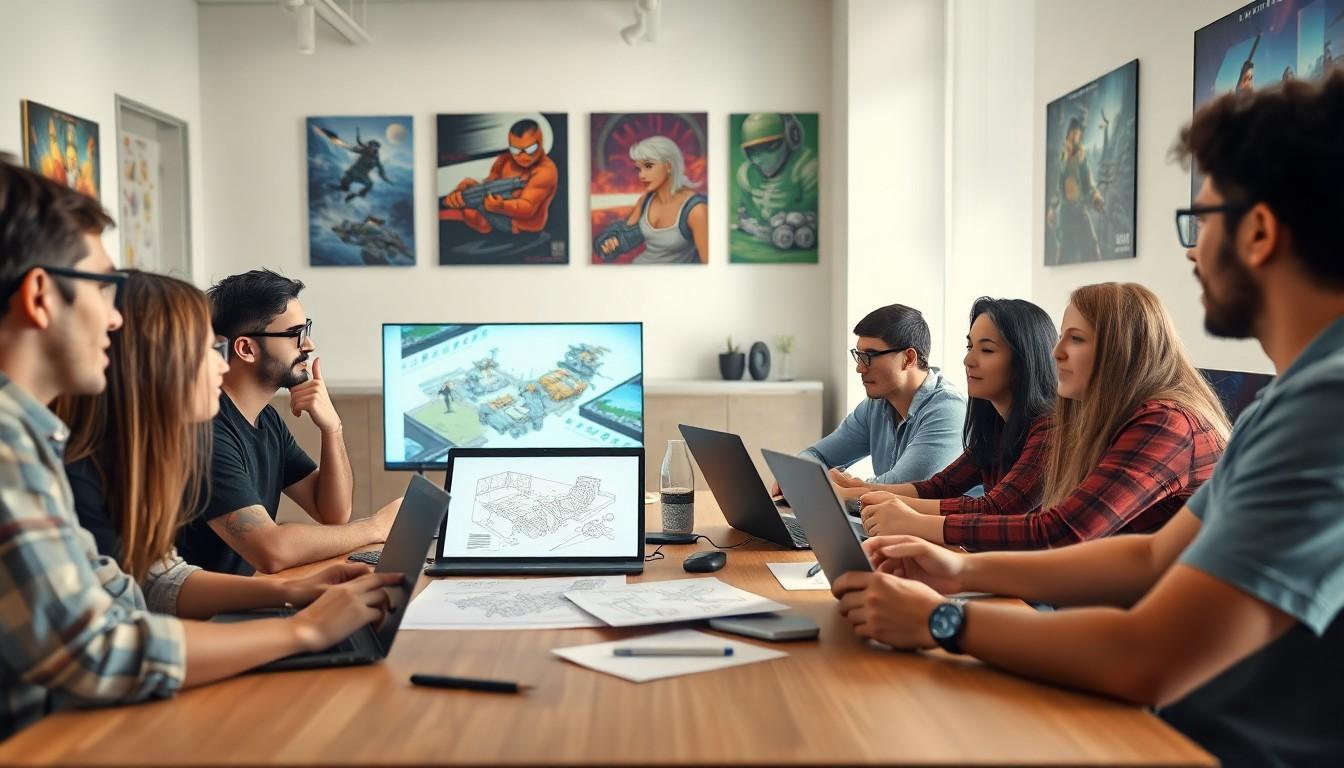
Game Development Process: Unlocking the Secrets to Creating Epic Games
In the world of gaming, every epic adventure starts with a spark of creativity and a dash of code. The game development process is like crafting a fine recipe—mixing art, technology, and a pinch of caffeine to create something that players can’t resist. From brainstorming wild ideas to debugging code that seems to have a mind of its own, this journey is as thrilling as the games themselves.
Game Development Process
The game development process consists of several distinct stages, each playing a crucial role in bringing a game from concept to completion. Initial brainstorming sessions generate innovative ideas that form the foundation of the game. Designers and developers collaboratively outline gameplay mechanics, storylines, and character development during this phase.
Once the concept solidifies, the pre-production stage begins. This stage involves creating prototypes and refining gameplay elements. Teams often develop detailed designs, documentation, and production schedules at this point. Clear objectives and timelines help align team efforts.
Following pre-production, production takes center stage. Programmers write code, artists create graphics, and sound designers develop audio assets. Collaboration remains vital as teams integrate various components into a cohesive game. Regular playtesting occurs throughout production, allowing for real-time feedback and adjustments.
After production, the testing phase ensures a polished final product. Quality assurance teams thoroughly examine the game for bugs and gameplay issues. Effective testing identifies problems and informs necessary fixes, maintaining high standards before release.
Finally, the launch phase arrives. Marketing strategies promote the game, generating anticipation among players. Once released, post-launch support becomes essential. Developers often provide patches, updates, and downloadable content to enhance the player experience.
By following these structured steps, the game development process combines creativity, technology, and dedication into engaging interactive experiences.
Pre-Production Phase

The pre-production phase sets the foundation for a successful game. This stage includes several critical steps that shape the project.
Concept Development
Concept development involves generating unique game ideas and themes. Teams brainstorm various concepts, focusing on gameplay mechanics and storytelling elements. Players’ interests play a crucial role in shaping these ideas. Creative collaboration encourages diverse perspectives, resulting in innovative game concepts. Documentation of each concept ensures clarity and alignment among team members.
Market Research
Market research collects data about industry trends and player preferences. Understanding target audiences helps identify competitive advantages and potential gaps in the market. Analysis of similar games reveals valuable insights into successful features and player engagement strategies. Surveys and player feedback contribute to refining game concepts. This research informs decisions that enhance the game’s potential success upon release.
Prototyping
Prototyping transforms concepts into tangible gameplay experiences. Developers create basic versions of the game to test mechanics and visualize ideas. Feedback from these prototypes guides further refinement of gameplay elements. Rapid iteration allows teams to explore different features and make adjustments quickly. Effective prototyping helps identify strengths and weaknesses before moving into full production.
Production Phase
The production phase represents the core of game development. This stage involves intense collaboration among team members to bring ideas to life.
Design Document
A design document serves as a blueprint for the game. It outlines gameplay mechanics, narrative elements, characters, and user interface specifications. By detailing these components, the design document guides developers throughout production. Teams constantly reference this document to ensure alignment with the original vision. Regular updates to the design document keep it relevant, reflecting any changes made during development.
Art and Sound Design
Art and sound design elevate the player experience. Artists create visuals, including characters, environments, and user interfaces, establishing an immersive atmosphere. Each visual element aligns with the game’s theme. Sound designers contribute equally, producing music and sound effects that enhance gameplay. Collaborations between these disciplines ensure cohesive integration of visual and audio elements. Feedback loops during this stage lead to refinements that improve both aesthetics and player engagement.
Programming and Implementation
Programming and implementation bring the game’s mechanics to life. Coders translate design concepts into functioning features. They write scripts for gameplay actions, artificial intelligence, and user interactions. This technical work enables seamless integration of art and sound elements. Collaboration among programmers fosters problem-solving and innovation. Continuous testing throughout this process helps identify bugs and optimize performance. Each iteration enhances game functionality, resulting in a polished final product.
Testing and Quality Assurance
Testing and quality assurance represent crucial phases in the game development process. These steps ensure that the final product meets player expectations and functions seamlessly.
Types of Testing
Various testing types contribute to identifying and resolving issues. Unit testing examines individual components for functionality. Integration testing checks how different parts of the game interact. Additionally, system testing evaluates the game as a whole, ensuring all elements work together smoothly. Regression testing verifies that new changes do not adversely affect existing features. Lastly, user acceptance testing gathers feedback from real players, providing valuable insights into gameplay experience.
Bug Tracking and Resolution
Effective bug tracking and resolution streamline the testing process. Numerous tools assist in logging and managing identified issues. Teams prioritize bugs based on severity and impact on gameplay. Once categorized, developers work systematically to fix problems. Communication among team members is vital for addressing bugs efficiently. Clear documentation supports tracking progress and ensures accountability. Continuous testing during this phase minimizes disruptions, leading to a polished game ready for launch.
Post-Production Phase
The post-production phase involves finalizing the game for release and ensuring its visibility in the market. Key activities during this stage include developing launch strategies and marketing efforts.
Launch Strategies
Launch strategies focus on timing and execution to maximize the game’s impact upon release. Teams evaluate optimal release windows based on competitor launches and seasonality. Coordinated marketing campaigns, including social media promotions and press outreach, help generate excitement. Two common strategies are soft launches, enabling teams to gather player feedback, and full-scale releases, where the game is available to all. Both approaches allow developers to adjust as necessary to ensure a successful entry into the market.
Marketing and Distribution
Marketing and distribution ensure the game reaches its target audience effectively. Creating a marketing plan involves identifying the target demographic and selecting appropriate channels. Teams often use social media, influencers, and gaming conventions to boost visibility. Distribution methods encompass physical and digital formats, with platforms like Steam, PlayStation, and Xbox all playing significant roles. Accomplishing successful marketing and distribution increases the chances of the game achieving its sales and player engagement goals.
The game development process is a dynamic and intricate journey that transforms creative ideas into immersive experiences. Each stage plays a vital role in ensuring the final product resonates with players and stands out in a competitive market. From initial brainstorming to post-launch strategies, developers blend creativity and technology with meticulous attention to detail.
By understanding and mastering these phases, teams can navigate challenges and enhance collaboration, ultimately delivering a polished game that captivates audiences. The dedication to refining gameplay and addressing player feedback is what truly elevates a game from concept to a beloved experience. Embracing this process not only fosters innovation but also paves the way for future successes in the ever-evolving landscape of game development.
